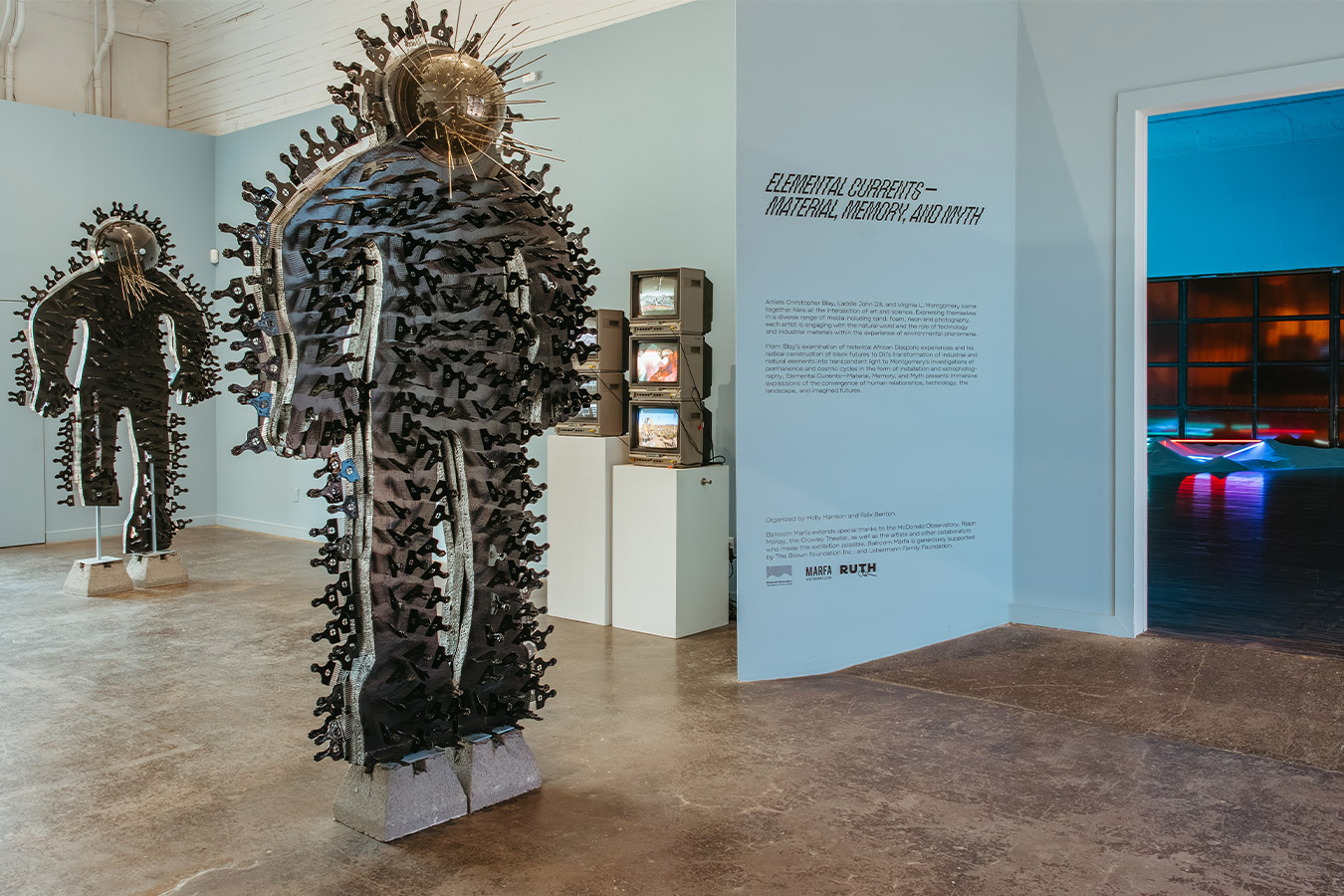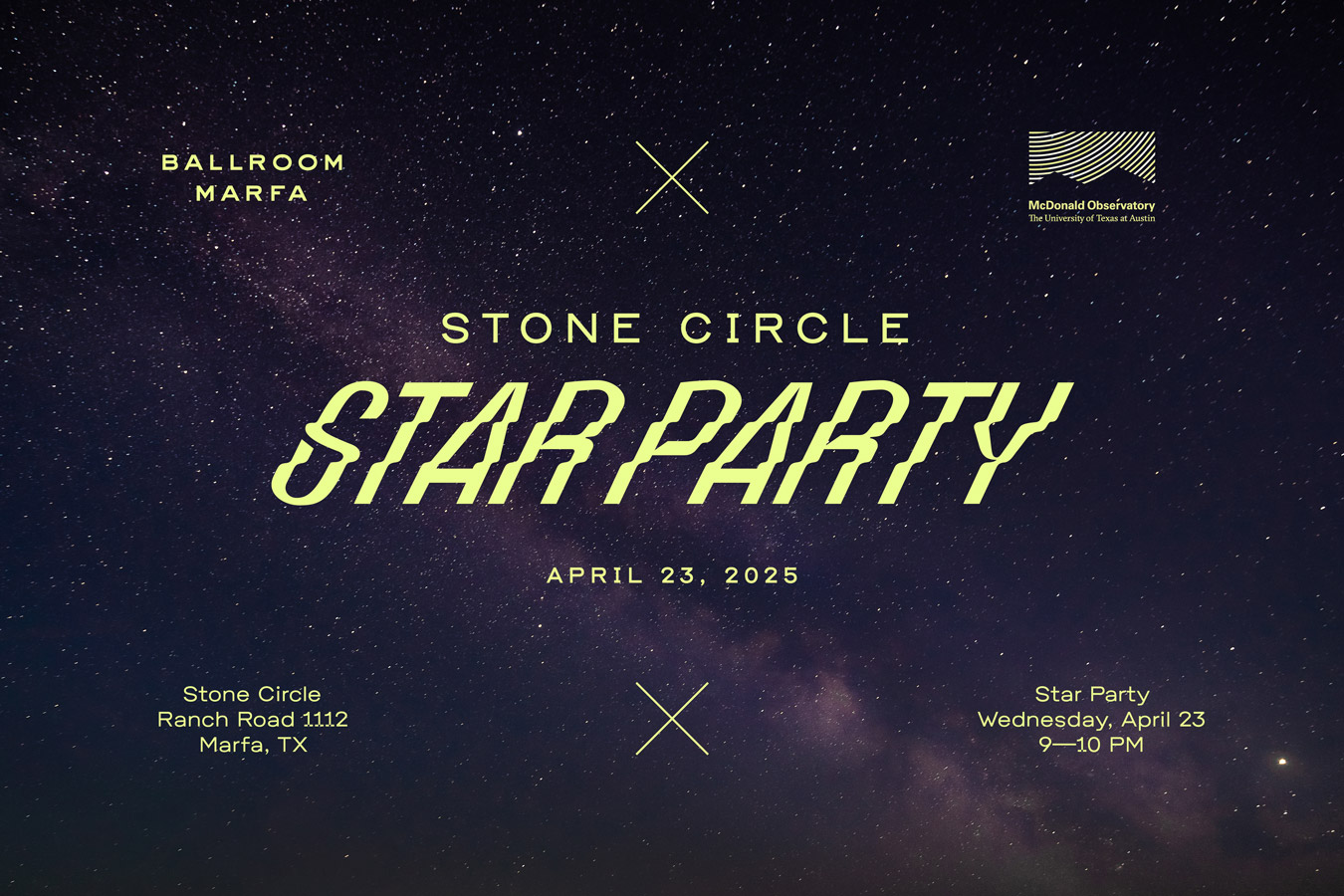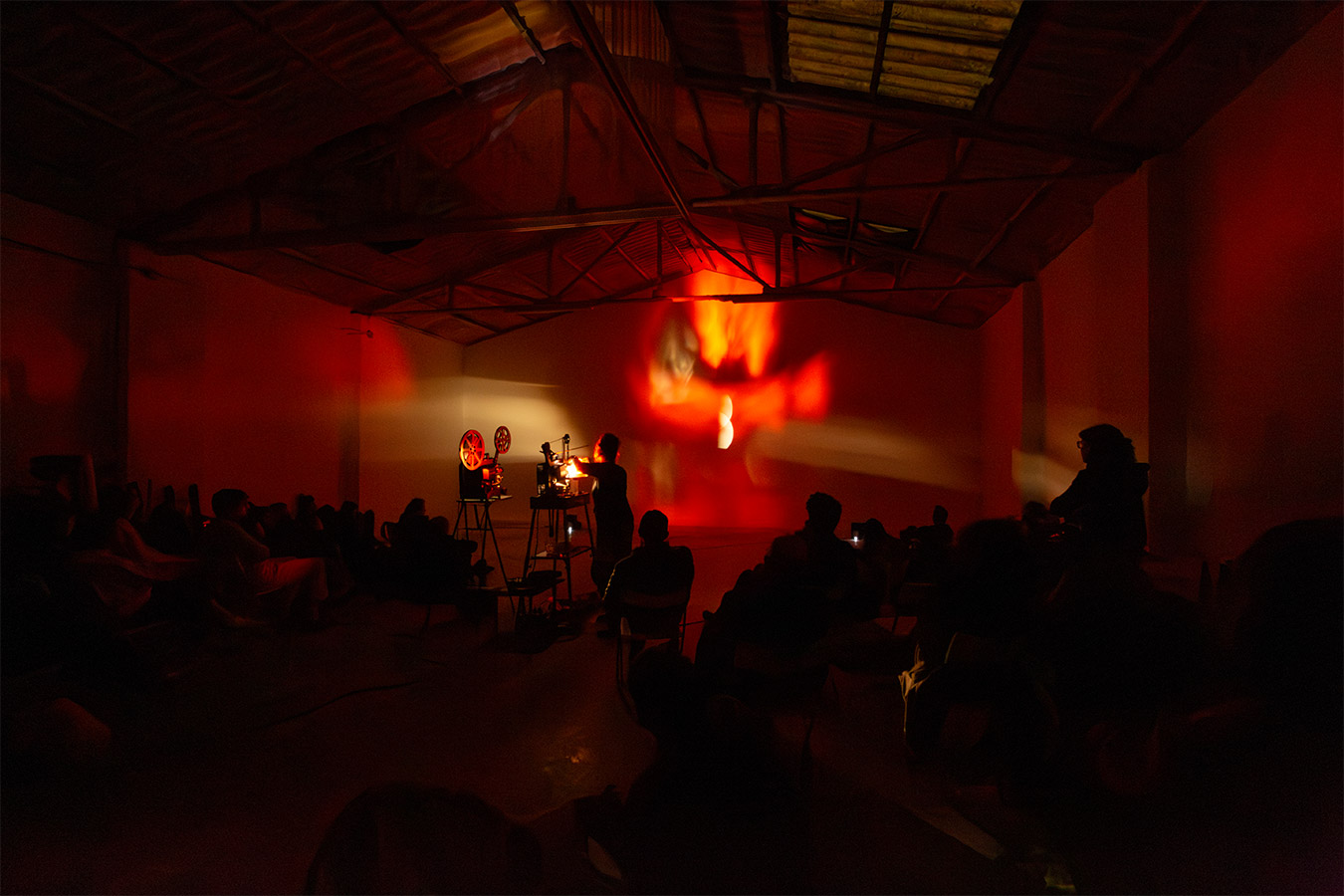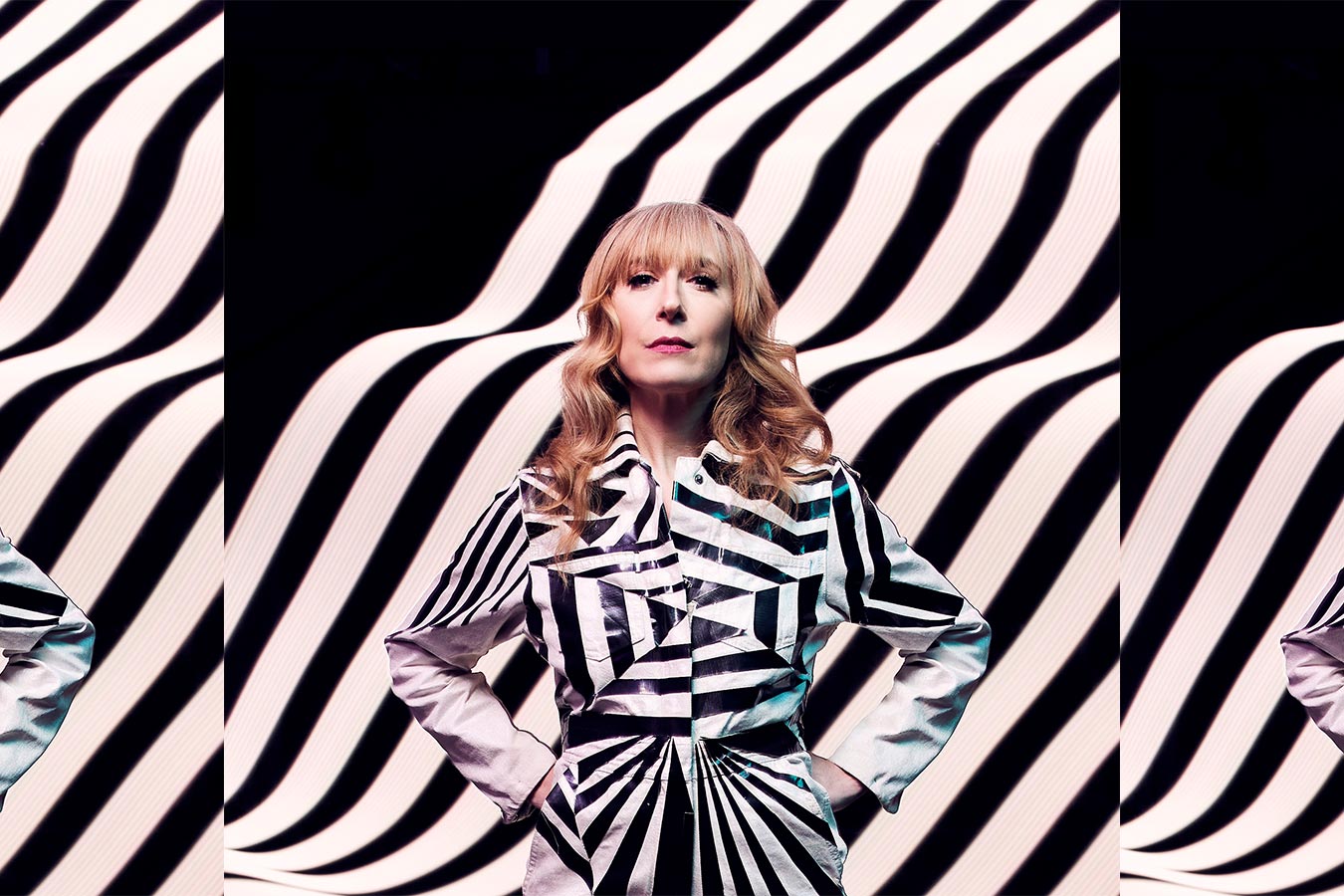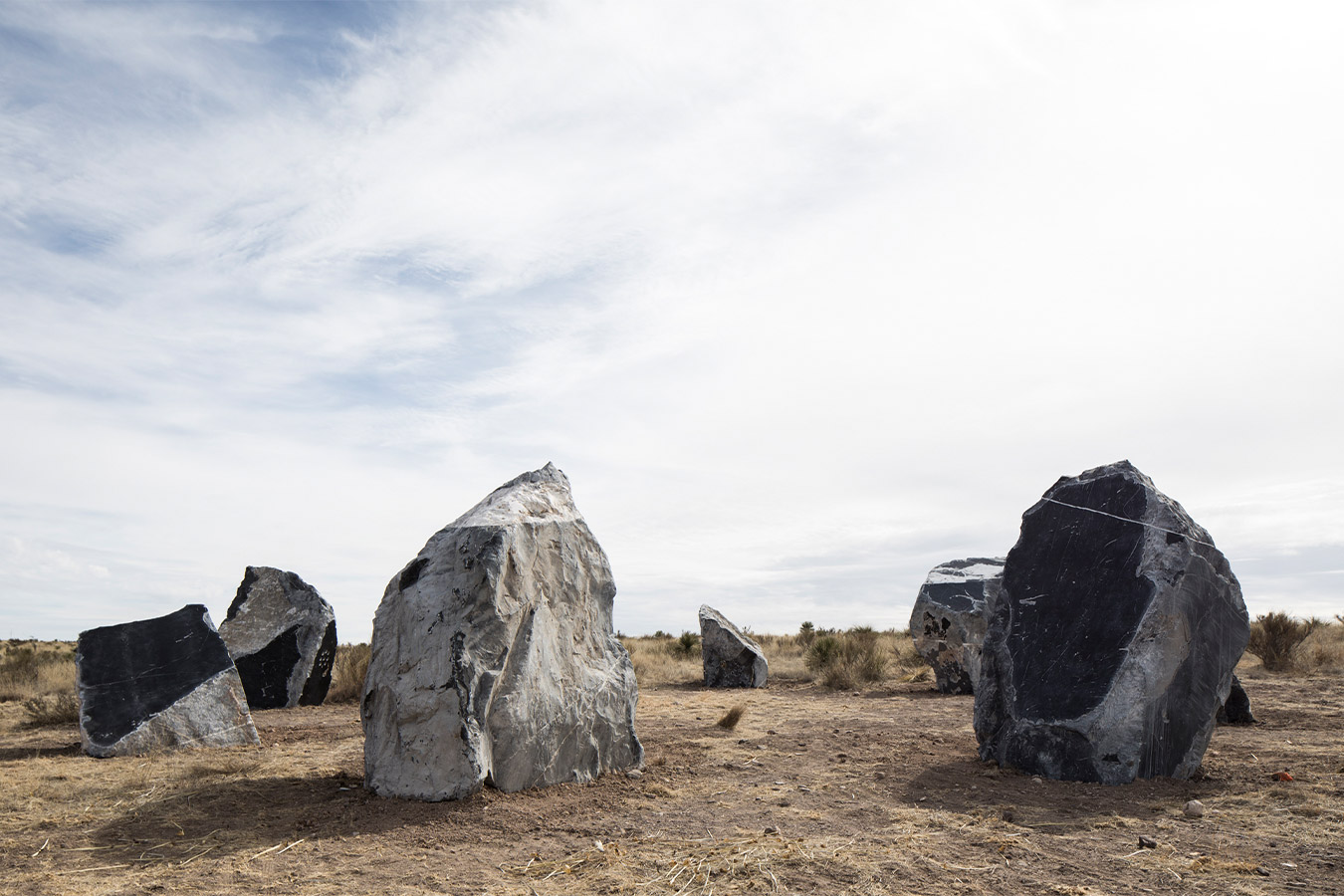
Arturo Herrera’s 88 DIA (1998), photo by Lesley Brown.
To commemorate the closing of Comic Future on February 2nd, we are presenting a series of essays and readings about some of the artists and their work represented in the show. Previously, we featured Walead Beshty, and his 2012 work, Unmasking. In this post, Ballroom’s Gallery Manager, Rebecca McGivney, discusses Arturo Herrera’s works in the show, including 88 DIA, which was commissioned specifically for Ballroom Marfa.
Comic Future will travel to the Wexner Center for the Arts in Columbus, Ohio where it will be on view from May 17 through August 3, 2014.
——————————————–
On the surface, Arturo Herrera’s two works in Comic Future, 88 DIA (1998) and Untitled (2001), look quite different. 88 DIA is a large colorful mural composed of a number of images. Though they at first appear somewhat abstract, the images quickly come into focus. A large potted plant topped by a red, spiky flower sits against a bright blue background. In the foreground, three cartoon birds fly above the figure of a girl. Although her head is hidden (or has been removed), she seems familiar.
Untitled also transforms the longer one focuses on it. At first it appears to be a large, black and white squiggle, somewhat reminiscent of a Jackson Pollock drip painting. It quickly becomes apparent that the entire drawing is composed of various recognizable shapes — namely some of the same shapes seen in 88 DIA. This is because both works use the same source material: Walt Disney’s 1937 classic, Snow White.
It is impressive that Herrera is able to disguise, even momentarily, such iconic images; but what is even more interesting is why he uses them at all. It is nothing new for an artist to take a familiar image and place it in a work of art; often, when one does so it is to critique and criticize what that image represents. As Roland Barthes notes in Mythologies: “the idols of consumer culture, car, refrigerator or screen goddess, have a totemic power in the modern age.” (Translated in S. Greeves, “The Language of the Wall”(MA Diss., the Courtauld Institute of Art, 1995), 29.) The most direct and effective way to break that power is by changing and subverting it. (see Sergei Chakhotin’s The Rape of the Masses: The Psychology of Totalitarian Political Propaganda, 1940)
Herrera, however, does not use these images expressly for the purpose of negation. Rather, they relate to his interest in modernism and its ideal of universality. In addition to Herrera’s various aesthetic references to modernism (his use of collage techniques and found material, as well as allusions to various artistic movements including surrealism, cubism, abstract expressionism, pop-art, and the affichistes, to name a few), the artist confirms that he is strongly attracted to the conceptual ideas behind modernism, particularly the belief that art is universal. As he explains in an interview: “Modernism’s boundless optimism and idealism created exciting visual realities. Some of these propositions failed or are no longer valid…. The key is to have a critical dialogue with this legacy.” Thus, while Herrera is attracted to these ideals, he differs in how he accomplishes them. While the modern artist hoped to create a work that could instantaneously convey its meaning through abstraction, Herrera uses the figurative and familiar to establish a “connection” and give the viewer something of which to grab hold: Snow White.
It is important to note that when Disney was first founded, the company’s work was seen as extremely modern. So much so that Sergei Eisenstein once declared Disney’s animations to be “the greatest contribution of the American people to art.” Walt Disney also shared in the modernist’s ideal of creating a universal art by appealing to our shared childhood. As he explained while defending his fantastical stories and imagery: “Everybody in the world was once a child. We grow up. Our personalities change, but in every one of us something remains of our childhood…. It just seems that if your picture hits that spot with one person, it’s going to hit that spot in almost everybody.” Herrera uses the same technique to entice the viewer into his work, the difference is that once one enters, Herrera, unlike Disney, no longer guides you. As he notes: “My work actually tries to discourage a specific message. It tries to free a place up, to clarify through ambiguity….You read the image very easily, but in the end, you are on your own.”
For more information on Herrera and his process, be sure to read his terrific conversation with Josiah McElheny from 2005 in Bomb. An excerpt:
The challenge is, how can an image so recognizable, like a dwarf, or a cartoon character’s foot or nose, or the red and blue specific to Snow White’s dress, have another meaning that I impose onto it? Is it possible? Can I make something so clear ambiguous? Can I uproot it? In which ways is the baggage that we bring to the new image relevant to the vivid recollections within our cultural context? I am attracted to juxtaposing invented images and readymade images without establishing explicit relations between elements.
From Herrera’s interview with Tom Friel of Bad At Sports:
Using everyday printed materials which are instantly recognizable leads the viewer directly into the image and at once a connection is established. Crashing our invented, private meanings onto a newly constructed image only adds to the impact of the original source. This undoing of linearity is attractive to me.
Finally, to see what Herrera is up to now, be sure to check out the images from his newest show, Books, at Corbett vs. Dempsey in Chicago. From a review at The Seen by Shreya Sethi:
These works come across as strong interventions into the act of reading. Using the help of stencils, Herrera haphazardly covers up the content of every page to the point of illegibility. We are forced to consider the nonrepresentational shapes foregrounded by the contents of the book, as a kind of linguistic information whose meaning we are left to determine.






